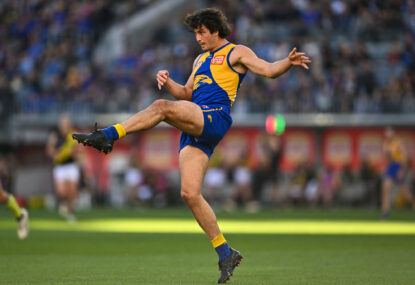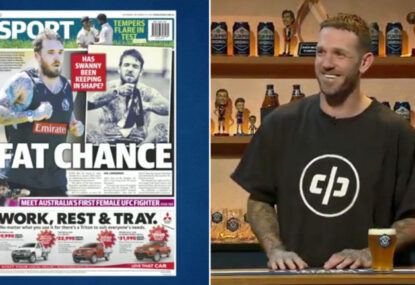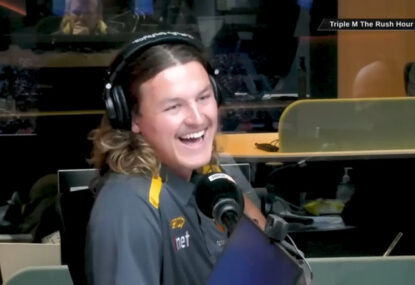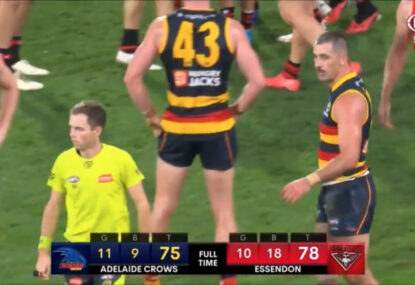The composite team has some of the greatest big men of all time, as well as some current players still going strong.
Back line
Graeme Yeats (Melbourne 1984-95)
182 games, 45 goals
Graeme Yeats began his career on the wing, and won Melbourne’s best first-year player award in 1984. He didn’t cement a spot until 1987 when Melbourne rose up the ladder, and eventually made the back pocket his own. Yeats played in the unsuccessful 1988 grand final, and continued as a consistent presence until 1993, when he was temporarily delisted. Leaving Melbourne in 1995, Yeats kicked the winning goal for Springvale in the 1996 VFL grand final.
Anthony Ingerson (Adelaide 1992-95, Melbourne 1996-2001)
158 games, 40 goals
Beginning his career with Central District in the SANFL, Anthony Ingerson won a best and fairest with that club in 1992 while also playing in Adelaide’s senior side on occasion. Having spent most of his time as a centre half forward, he was converted to defence at Melbourne and became one of the more prominent key backs of the late 1990s. Ingerson finished fifth in Melbourne’s best and fairest in 1997, and was selected in the South Australia squad in 1999 although he did not play. He lined up on Matthew Lloyd in the 2000 grand final, and struggled through injury in his last season.
Mark Zanotti (West Coast 1987-88, Brisbane 1989-92, Fitzroy 1993-95)
157 games, 19 goals
An athletic and pacy defender,Mark Zanotti stood out for Subiaco early in his career and won a Simpson Medal for best on ground in the 1986 WAFL grand final. This led to his selection in the inaugural West Coast squad, and he lined up on the half back flank in the Eagles’ first game. After two seasons, Zanotti transferred to Brisbane and finished third in the club’s best and fairest in 1990. He represented Western Australia five times, and spent his last years at Fitzroy, including a six-match stretch in 1995 where he topped 23 disposals each game.
Half back line
Steven Icke (North Melbourne 1975-81, Melbourne 1982-87)
198 games, 50 goals
Steven Icke was equally comfortable at half forward or half back, being capable of taking a good mark and launching an attack with skill. He was named at half forward in the 1977 grand finals, kicking 1.4 in the replay. Icke’s versatility made him an attractive proposition for other clubs, and he was sold to Melbourne prior to the 1982 season. He made the most of the new environment, winning a best and fairest in his first season, and representing Victoria in 1983 and 1984. Icke’s career was shortened by injuries to his Achilles tendon and ACL, playing only two games in his final season.
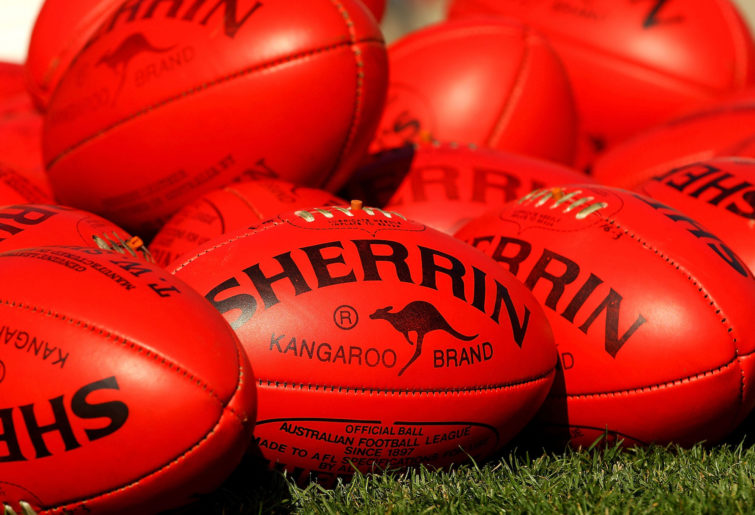
(Photo by Mark Dadswell/Getty Images)
Mark Yeates (Geelong 1980-90)
154 games, 57 goals
Mark Yeates is synonymous with one of the most infamous moments in VFL grand final history – charging off the square at the bounce of the 1989 grand final, he flattened Dermott Brereton with a ferocious bump. Prior to that, Yeates had been an effective player in most key positions, generally being stationed at centre half back. It was there that he played for Victoria in 1983 and 1986. After leaving Geelong, Yeates captain-coached North Hobart to two straight flags in the TFL.
Garrick Ibbotson (Fremantle 2007-17)
177 games, 22 goals
A dependable half back over the course of a decade for Fremantle, Garrick Ibbotson was one of the fastest players on Fremantle’s list for most of his career. Playing only one game in his first season, he was nominated for the Rising Star award in 2008 after a 21-disposal effort against Carlton. Two years later, Ibbotson was part of the Australian squad for the International Rules series. He continued as a generally consistent presence throughout the decade, having his best year in 2015 when he played 24 games. Ibbotson retired after the 2017 season having played every match up to Round 10 and none afterwards.
Centre line
Bryan Quirk (Carlton 1965-75)
167 games, 113 goals
Bryan Quirk was recruited to Carlton as a lightly framed centre half forward, who Ron Barassi quickly set about shifting to the flanks. He was skilled enough to lead the club’s goal kicking in his first season, but blossomed when moved to the wing in order to combat the great Richmond centre line. With great acceleration and long kicking ability, Quirk became a key driver in Carlton’s midfield, playing in the 1968 premiership and being universally considered best on ground in 1969 despite Carlton’s loss. Injury and bad luck prevented him playing in Carlton’s 1970 and 1972 premierships, and he finished his career after a losing final in 1975 before stepping in as coach of the under-19s and reserves squads in the late 1970s and early 1980s.
Ricky Quade (South Melbourne 1970-80)
164 games, 110 goals
When the Sydney Swans ran out for their first game under that name, it was appropriate that one of the best Swans of the past decade as South Melbourne was at the helm. Ricky Quade was a tough and determined ruck rover whose brothers Tom and Mike had both played a handful of games for North Melbourne. He ruptured an ACL in his debut, but recovered to win Sydney’s best and fairest in 1976 and captain the club from 1977 to 1979. One of his best performances came in his final season, picking up 38 disposals to help hold Essendon at bay by four points. Quade stepped in to coach once the move to Sydney was completed, and retired in 1984 but has served the club in various off-field roles since then.
David Zaharakis (Essendon 2009-)
217 games, 134 goals
A prolific midfielder who is capable of running forward to kick an important goal, David Zaharakis made his name in Essendon folklore by the end of his fourth match. In the teeming rain of an Anzac Day clash with Collingwood, Zaharakis kicked a goal with a minute remaining to put Essendon in front and hold on for a dramatic win. He continued in that vein over the next few years, winning a best and fairest award in 2011 and an Anzac Medal for best on ground in 2013 after 34 touches and four goals. Zaharakis has remained consistent throughout the decade, regularly picking up over 20 possessions, and has shifted to the half back line in 2020.
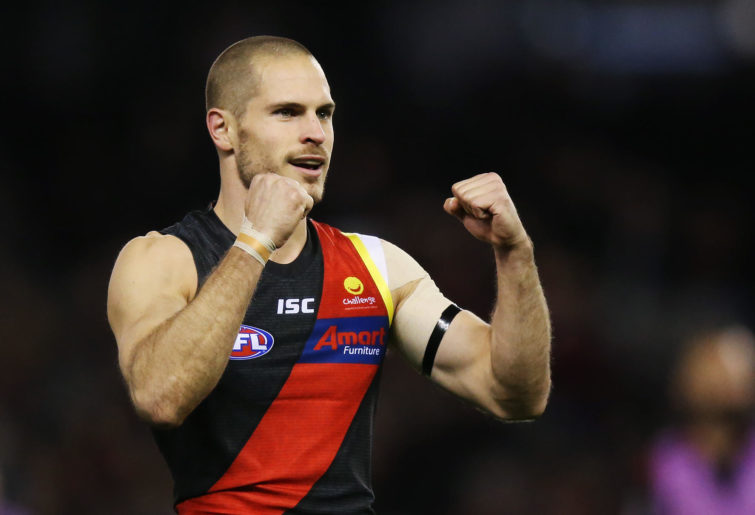
(Michael Dodge/Getty Images)
Ruck line
Henry Young (Geelong 1897-1910)
167 games, 76 goals
Henry ‘Tracker’ Young had already played for seven seasons in the VFA with Geelong by the time the VFL was formed. As a remarkably fit and agile ruckman, his tap work to rovers was without peer. After Peter Burns departed in 1900, there was never a question of who would take over the captaincy, and Young became one of the most respected figures in the league. Of his 167 VFL games, 137 were as captain. Young won Geelong’s best and fairest award in 1905 and 1906, and had intended to retire after the 1909 season. He was drafted in to help the club qualify for finals in 1910, but once it became clear Geelong would miss out he hung up the boots for good. Young was named in the forward pocket of Geelong’s Team of the Century.
Elliot Yeo (Brisbane 2012-13, West Coast 2014-)
165 games, 70 goals
Elliot Yeo showed flashes of promise in his two years with Brisbane, but was part of the infamous ‘Go Home Five’ after the 2013 season. Joining West Coast, he quickly established himself at half back, although he suffered a dirty day in the grand final of that year. Yeo rose to greater prominence in 2017 with his first All Australian selection and a best and fairest award. He won the best and fairest the following year too, along with a role in the premiership side and a Glendinning-Allan Medal for best on ground in the Western Derby. Yeo was named All Australian again in 2019 and continued his good form into 2020 until osteitis pubis derailed his season.
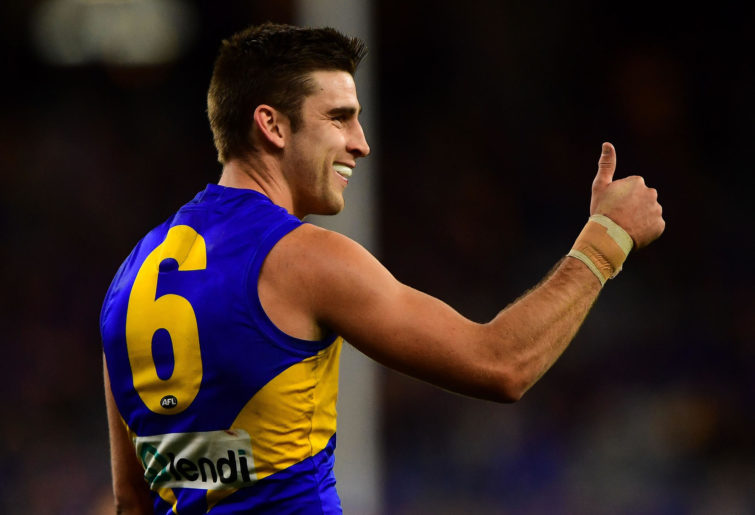
(Photo by Daniel Carson/AFL Photos via Getty Images)
Warwick Irwin (Fitzroy 1970-80, 1983, Collingwood 1981)
229 games, 244 goals
One of the finest rovers of the 1970s, Warwick Irwin represented Victoria with regularity throughout the decade. Able to sniff a goal and eight times kicking four or more in a game, he won Fitzroy’s best and fairest award in 1975. Following the 1980 season, Collingwood lured Irwin across with a view to making the final jump to a premiership, and he played in the unsuccessful 1981 grand final before sitting out the 1982 season with injury. He returned to Fitzroy for one final season before playing with Port Melbourne in the VFA. Irwin was named on the wing of Fitzroy’s Team of the Century.
Half forward line
Adem Yze (Melbourne 1995-2008)
271 games, 234 goals
Durable, consistent, and brilliant, Adem Yze was a weapon for Melbourne over the course of a decade after being drafted in 1994. He was nominated for the Rising Star award in 1996, and the following year played the first of 226 consecutive games. Yze’s kicking was especially notable, and he led the league in total kicks three times. He won Melbourne’s best and fairest in 2001 and was named All Australian the following year. A new role in 2005 saw Yze kick 41 goals, and he followed up with 30 the following year before losing form. He left Melbourne after the 2008 season when the club was embracing a youth strategy.
Bernie Quinlan (Footscray 1969-77, Fitzroy 1978-86)
366 games, 817 goals
Bernie Quinlan was able to kick the ball incredible distances, hence the nickname ‘Superboot’. At Footscray he was a solid centre half forward, leading the club’s goal kicking in 1971, before being cleared to Fitzroy for $70,000. After two seasons, Quinlan wanted to retire to spend more time on the farm, but the club lured him back and he played the best footy of his career. In 1981 he shared the Brownlow Medal with friend and ex-Footscray teammate Barry Round, before he won Coleman Medals in 1983 and 1984, kicking over 100 goals each time. Quinlan became the first player to play 150 games for two clubs, and retired after the 1986 season, having only just failed to reach the grand final. Indeed, he holds the record for most games without playing in a grand final. Quinlan was named as centre half forward in Fitzroy’s Team of the Century, and has the honour of having the Brisbane Lions’ mascot Bernie Vegas named after him.

(Photo by Michael Dodge/AFL Media/Getty Images)
Tommy Quinn (Geelong 1931-40)
168 games, 169 goals
As part of the great Quinn family for Port Adelaide in the early part of last century, Tommy Quinn won an SANFL flag in his first year, and attracted the attention of Geelong scouts after a starring display for South Australia. Coming across to help the club get over the hump against the Collingwood ‘Machine’, Quinn again won a premiership in his first season, forming a deadly roving combination with Ted Baker. He was a tenacious and physically imposing player, winning best and fairest awards in 1936 and 1937. In the latter year, Quinn was seen as best on ground in the grand final as Geelong won another premiership. He was named as an emergency in Geelong’s Team of the Century.
Forward line
George Young (St Kilda 1973-78)
108 games, 284 goals
George Young was a star for Subiaco in the WAFL and regularly featured for Western Australia before moving across to St Kilda. His first few seasons were spent on the half forward flank, but once he moved closer to goal stood out as a prolific goal kicker. Young led St Kilda’s goal kicking on four straight occasions, with a best of 70 goals in his final season, before returning to Subiaco for one last match. He was named on the half forward flank of Subiaco’s Team of the Century, and also played two first-class cricket matches for WA, scoring a century against South Australia.
Bill Young (St Kilda 1956-61)
94 games, 274 goals
Two players have led the VFL/AFL goal kicking in their debut season – John Coleman and Bill Young. Young had been a superstar in the Gippsland League, with multiple clubs from the VFL and VFA each vying for his signature. St Kilda won out, and he served them well in using his intelligence and accurate kicking to lead the club’s goal kicking in each of his first five seasons. Young represented Victoria in 1959, and was credited with the invention of the banana kick. He departed the club after the 1961 season and returned for a year as assistant coach in 1963.
Dayne Zorko (Brisbane 2012-)
184 games, 193 goals
Dayne Zorko has been an important part of the Brisbane side for much of the decade. Starting out as a flighty half forward who was able to kick a freakish goal, he started to move into the midfield and become a prime mover there. Zorko won four straight best and fairest awards from 2015-18, and led the club’s goal kicking in 2016 and 2017. He was named All Australian in 2017 and promoted to captain in 2018 when Dayne Beams stepped down. Zorko looms as a vital cog in Brisbane’s attempt to win the premiership this year and is set to continue his good form in future.
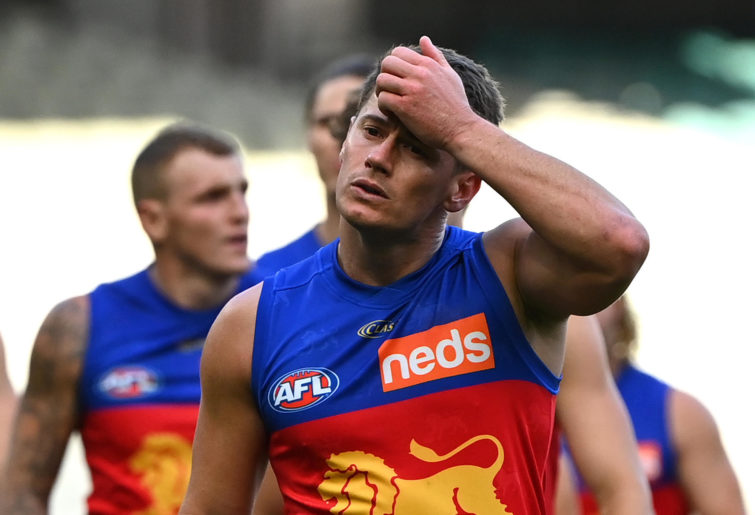
(Photo by Quinn Rooney/Getty Images)
Interchange
Charles Utting (Collingwood 1943-50)
125 games, 17 goals
Charles Utting was a devoted Collingwood man from the moment he walked in the door. Tough, determined and skilled with each foot, Utting spent most of his career in the back pocket tormenting opposing rovers, but made the most of things when shifted into the centre. He finished third in the best and fairest in 1949, and won the award in 1950 – the same year he represented Victoria. Unfortunately, Utting had to leave the club after the season to continue the family business, and he shunned offers from other clubs to continue his career as he preferred to give back to the community. In later years he coached the reserves and served on the Collingwood committee for eight years.
Ernest Utting (Collingwood 1919-22, Hawthorn 1925-32)
117 games, 57 goals
Charles Utting made a better name for himself than his uncle Ernest, who first played for the Magpies for a single game in 1919. The following year he led the club’s goal kicking, feeding off the likes of Dick Lee, but was occasionally criticised for lack of consistency. After three more games in 1922, Utting left the club to join Hawthorn in the VFA, where he became one of the club’s first superstars. He was moved to the back pocket where his attack on the ball and opponents was conspicuous, and he won two best and fairest awards while with Hawthorn. Utting also finished third in the 1929 Brownlow Medal, and retired having become the first Hawthorn player to reach 100 games for the club.
Eric Zschech (Richmond 1930-35)
102 games, 16 goals
Eric Zschech played for only six years in the VFL, but made a name for himself as part of one of the most brilliant centre lines in the league along with Allan Geddes and Stan Judkins. Zschech was a clever centreman with excellent foot skills, and played in the 1932 and 1934 premierships. He represented Victoria in 1934, and departed for Tasmania after the 1935 season. There Zschech represented the state twice, and won the George Watt Medal for TANFL best and fairest three times and captain-coached Lefroy to the 1937 premiership.
Jack Ziebell (North Melbourne 2009-)
218 games, 163 goals
As a tough and skilled midfielder who can also move forward when the occasion demands it, Jack Ziebell has been a consistent player for North Melbourne for over a decade. He was nominated for the Rising Star award in 2009 and considered one of the favourites to win until he broke his leg in Round 12. He continued to develop and show his leadership abilities, taking an extra step forward in 2013 when his goal kicking became more notable. That year Ziebell was named in the 22 Under 22 Team, and he was named captain in 2017 after Andrew Swallow stepped down. He celebrated 200 games in 2019 with 28 touches and two goals against Gold Coast, and will be lending his experience to the next generation of North Melbourne players as they begin a rebuild.
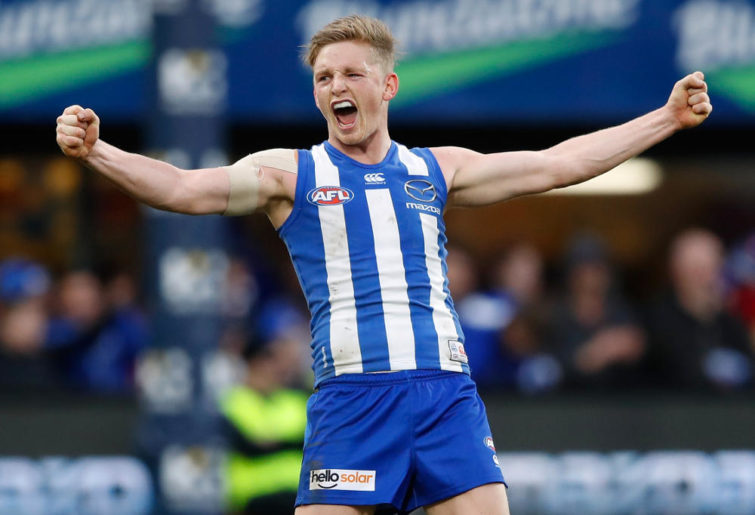
(Photo by Adam Trafford/AFL Media/Getty Images)
Emergencies
Chris Yarran (Carlton 2009-15)
119 games, 90 goals
Chris Yarran was blessed with incredible pace and skill, exciting Carlton supporters for a few seasons no matter where he played on the field. His early seasons were spent in the forward line along Eddie Betts and Jeff Garlett as part of ‘Setanta’s Little Helpers’, and he was nominated for the Rising Star award in 2010 after a starring role in Round 1. The following year, Yarran was moved to half back where his pinpoint kicking and breakaway pace were handy in setting up many a Carlton attack. He kicked Goal of the Year in 2012 corralled against the boundary line, and had his best year in 2014 when he finished fourth in the best and fairest. The following year, Yarran’s enthusiasm had waned, and he was traded to Richmond where he didn’t play a game before being released.
Alex Ishchenko (West Coast 1987-88, Brisbane 1989-91, North Melbourne 1992-95)
142 games, 37 goals
The ruckman in West Coast’s inaugural team in 1987, Alex Ishchenko was a capable player who never developed to become a dominant big man. He was still an important link in the West Coast chain for two years before being traded to Brisbane and playing in their reserves premiership of 1991. Known as the ‘Big Russian’ despite Ukrainian heritage, Ishschenko’s best year was 1992 when he finished third in North Melbourne’s best and fairest count.
Barry Young (Richmond 1989-93, Essendon 1994-99, Hawthorn 2000)
142 games, 68 goals
A hard-at-it midfielder who was no stranger to the tribunal, Barry Young was a solid if unspectacular player at Richmond for five years, but represented Victoria in 1990 against Tasmania. After being picked up by the Bombers, Young developed a reputation for being one of the club’s better performers in finals, including 19 possessions in the 1996 preliminary final and an eye-catching goal in the 1999 thriller. His best year was in 1999 having recovered from two injury disrupted seasons to play 20 matches before a contract dispute saw him leave the club. Young spent one year at Hawthorn to middling effect before retiring.
There we have it – 21 teams of varying skills and quality, from the earliest days of the league to now. Which team would be the best? Would I make any changes? That’s for a follow-up article.



































































































